<-Previous Species – Next Species->
A scarce vagrant to Yorkshire.
www.yorkshiredragonflies.org.uk
<-Previous Species – Next Species->
43mm, Wings 76mm
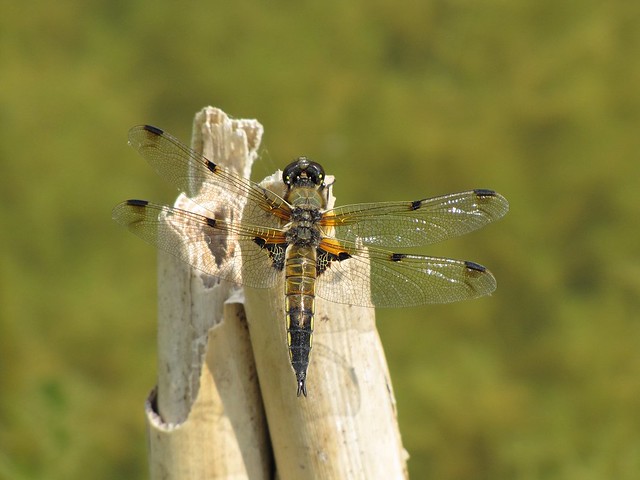
Thorax brown, no antehumeral stripes; abdomen brown, last 4 segments darker than the rest, yellow spots on sides; wings dark patches at nodes on leading edges and at bases of rear wings.
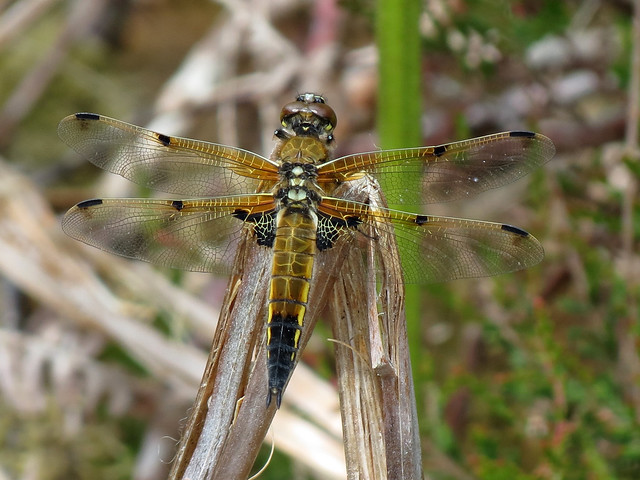
Similar to males, main difference is the shape of the anal appendages.
Prefers sites of still water consisting of lakes, ponds, bog pools, canals and dykes. Will tolerate brackish conditions. The largest concentrations are associated with acidic ponds and pools.
Males are territorial, their noisy clashes are obvious where densities are high. Readily returns to the same perch on emergent vegetation, after sparring with other males, or after short patrols along the waters edge. Copulation is short taking place in flight, only lasting for 5-20 seconds. Female oviposits by flicking the abdomen tip downwards into the water. The eggs then sink and adhere to submerged vegetation. Males may stay close by to guard females during oviposition. Larvae live among the bottom debris, then emerge after two to four years. Emergence takes place amongst marginal vegetation during daylight hours.
<-Previous Species – Next Species->
44mm, Wings 76mm
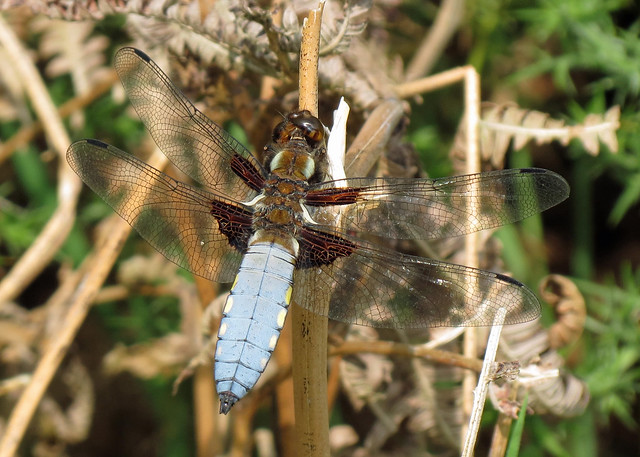
Thorax brown, pale, broad antehumeral stripes; brown patches at base of wings; broad abdomen blue with yellow spots at sides, legs brown, eyes brown.
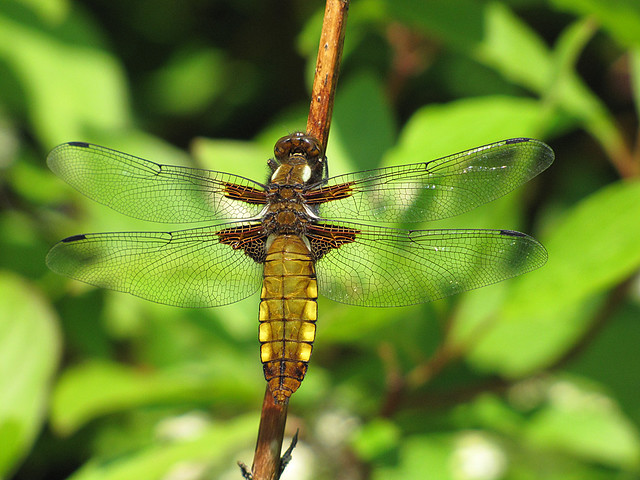
Thorax brown, pale, broad antehumeral stripes; abdomen yellowish brown with yellow spots along sides; wings brown base areas.
Both sexes yellowish.
Small lakes, ponds, garden ponds, ditches and canals with well-vegetated margins and sheltered sunny locations. Will use bog pools if they are not too acidic. Often, one of the first species to colonise new water bodies.
Males are aggressively territorial, there seldom being more than one male at any small pond. They perch on stems of tall emergent vegetation, or on the ground, chasing off any intruding males that appear within their territory. Copulation takes place in flight, lasting for only a few seconds. The female oviposits by flicking the tip of her abdomen into the water rapidly, occasionally with the male guarding her nearby. Larvae live amongst the bottom debris, emerging after two to three years. Emergence at sites is usually synchronous on marginal and emergent vegetation.
Widespread though scarce in VC65 Noert-east Yorkshire.
<-Previous Species – Next Species->
50mm, Wings 78mm
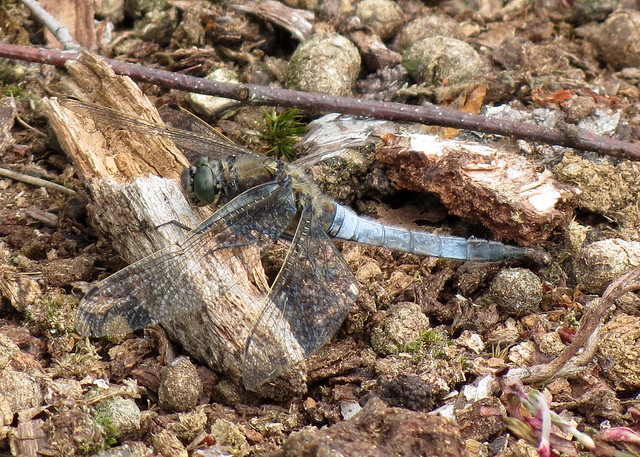
Thorax black, no antehumeral stripes; Abdomen top is blue with yellow spots towards sides, black tip; legs black.
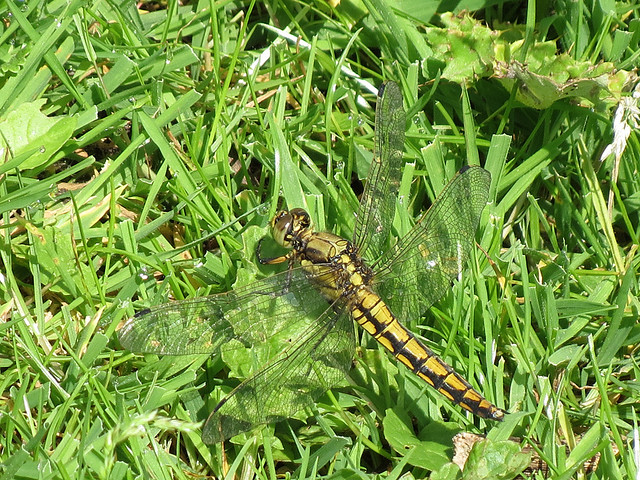
All yellow with 2 black bands on upper surface abdomen.
Prefers lakes, ponds, gravel workings, slow rivers or marshes, with exposed mud, stones or bare patches where the male can perch.
Highly territorial, males perch on bare areas of ground, typically on slightly raised areas such as stones, logs or bare soil, on the lookout for females and rival males. When patrolling over water they fly low, skimming over the surface. Copulation can take place in flight, where it will only last for a few seconds, though sometimes this can take place in vegetation where it may last up to 15 minutes. Oviposition occurs by dipping the abdomen into water, with the male often remaining nearby. Larvae live amongst the bottom silts, emerging after two to three years. Emergence usually takes place on vegetation, often several metres away from water.
<-Previous Species – Next Species->
36-46mm; Wingspan: Male 57-63mm; Hindwing 28-34mm; Larva: 17-23mm
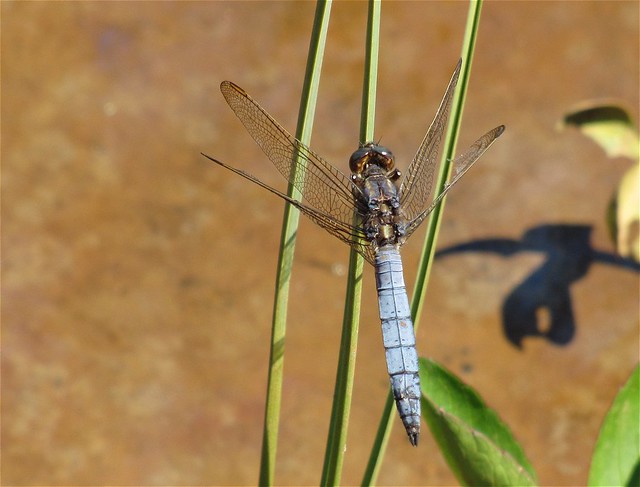
Dark brown thorax with buff antehumeral stripes, which fade with age. When mature the abdomen is blue, except S1. Blue grey eyes. Wings have a yellow tint when immature which clear as they mature. Pale yellow costa and orange pterostigma. Blue grey eyes.
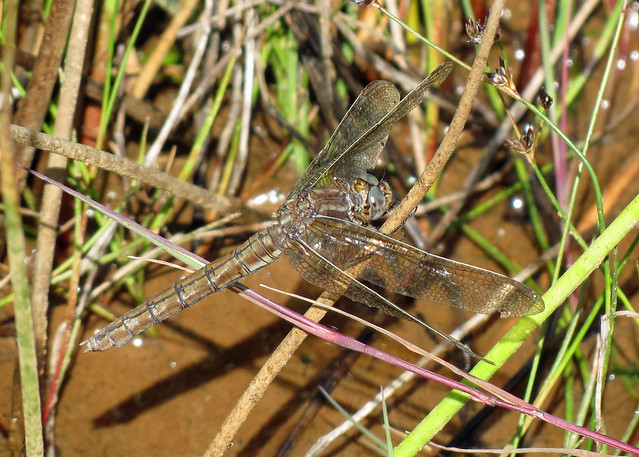
Dark brown thorax with buff antehumeral stripes. The abdomen is a yellow/brown colour with a thin dark keel line down the centre. Pale yellow costa and orange pterostigma.
Males have small territories observing them from the ground or low perches. Copulation occurs on the ground and can last anything from 2-60 minutes. Flight is fast and erratic with brief spells of hovering. Wings are held well forward when at rest. Females spend a lot of time resting in vegetation not far from water.
Acidic wet heath and peaty moorland sites typically with sphagnum mosses, frequents pools, runnels and streams.
Confined to VC62 where it appears to be present in suitable sites surrounding Fylingdales Moor. Several records of dispersing individuals.
<-Previous Species – Next Species->
37mm, Wings 57mm.
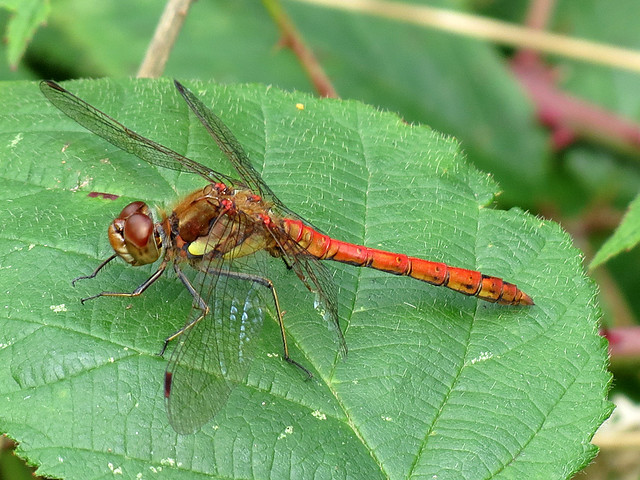
Thorax brown with yellow patches on sides; abdomen orange/red with black central line last 2 segments ; legs black/yellow; eyes brownish; black line on top of the frons only.
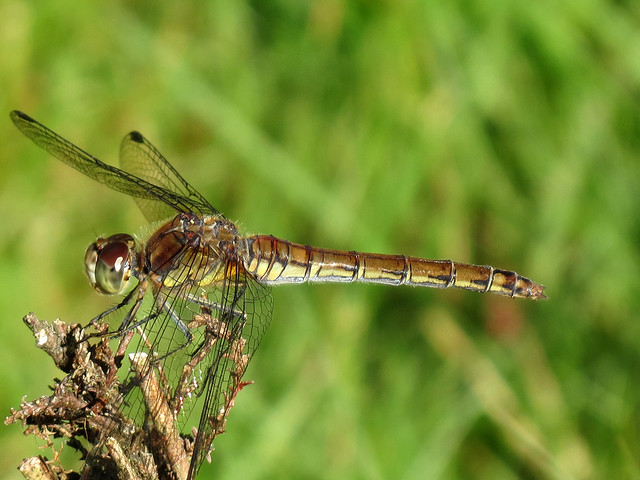
Thorax pale brown with yellow side panels; abdomen yellow with black central line segments 9-10 and along sides. Old females tend to take on male colours.
Preferences are quite catholic, including ponds, lakes, canals, ditches and slow-flowing rivers. It is tolerant of brackish conditions and peaty bog pools. Can be found away from breeding sites feeding in sheltered locations, like woodland rides and hedgerows.
Males are territorial, spending a lot of time perched, only making short flights when disturbed or chasing off intruders. Basks on the ground, especially late in the season when temperatures are lower. Frequently found away from water in sheltered areas, especially females wanting to avoid attention from males. Copulation takes place at rest, lasting around 10-15 minutes. Oviposition regularly takes place in tandem, where the eggs are flicked into the water by dipping the abdomen onto the surface. Females will also oviposit alone. Larvae emerge after one year, this taking place during the morning, onto bare bank sides or emergent vegetation.
<-Previous Species – Next Species->
40mm, Wings 63mm
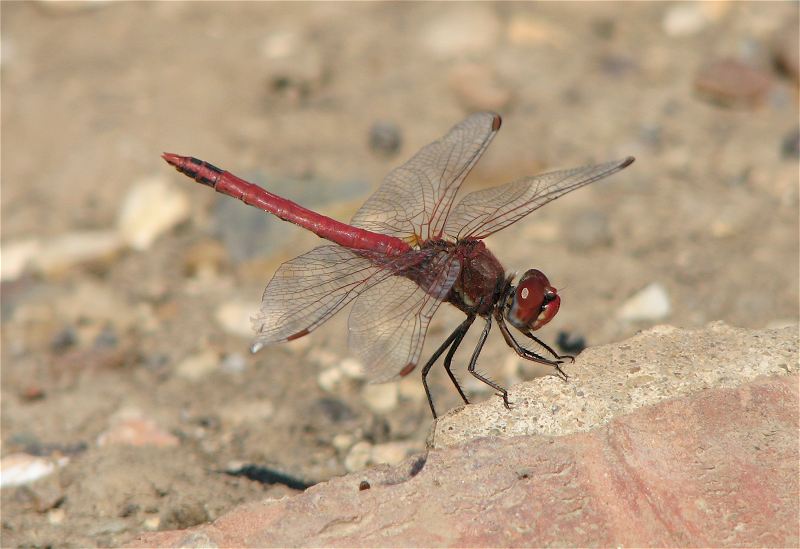
Brick red colour with central black line on segments 8 and 9; basal veins of wings near leading edges are red with a yellow patch at the base of the hind wing; underside of eyes are blue.
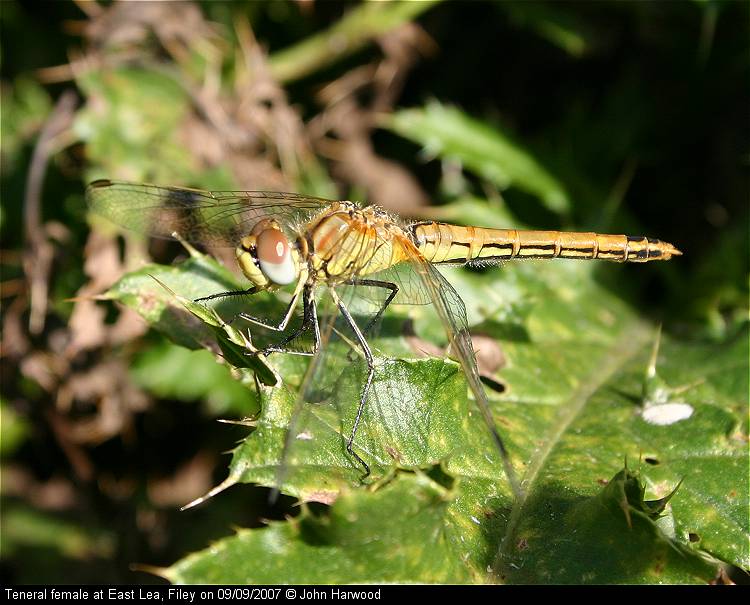
Body yellow with central black line on segments 8 and 9; yellow patch at base of hind wings and veins at front edge of wings also yellow; underside of eyes blue.
Vagrant from Europe, although it has colonized some areas of Great Britain. In the East Riding the best site is the scrape in Clubley’s field at Spurn Point. Shallow ponds, pools and ditches.
Males are territorial, perching on the ground or adjacent vegetation, only flying off to intercept intruders. Frequently hovers over open water. The pair usually oviposit in tandem in areas of shallow water. The warmer water in shallow conditions helps the larvae develop quickly, sometimes resulting in a second generation emerging in the same year. They are strongly migratory, with strong influxes in some years, then none in others. These irregular influxes make it difficult to assess if this species is breeding on a regular basis.
<-Previous Species – Next Species->
34mm, Wings 55mm
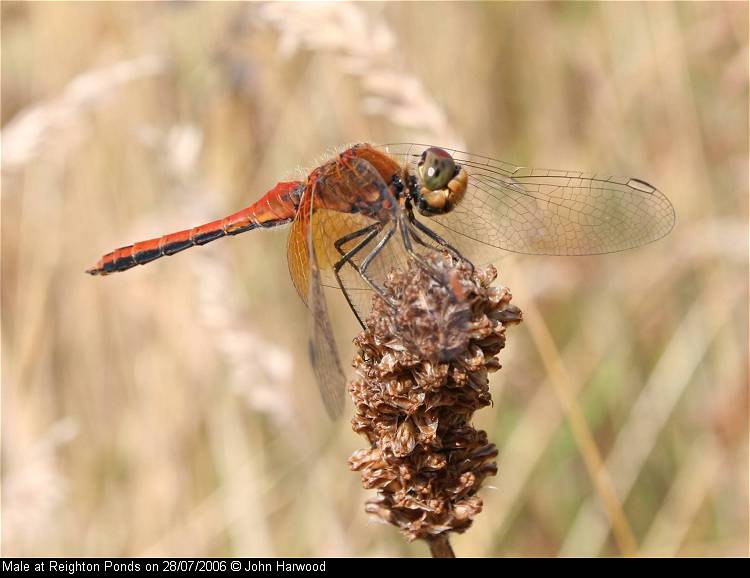
Thorax reddish-brown, and abdomen orange-red. Yellow suffusion to basal half of wings and veins.
Thorax and abdomen yellow-brown. Yellow suffusion to basal half of wings and veins less extensive than males.
Vagrant from Europe, marshy pools, lakes and ditches.
<-Previous Species – Next Species->
34mm, Wings 55mm.
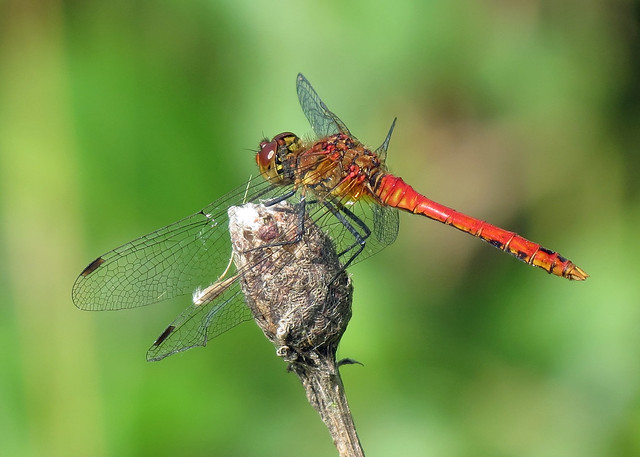
Thorax brown with 2 thin black lines on sides; abdomen narrow waist, rich red colour; face red; legs all black; line over frons spreads down the sides.
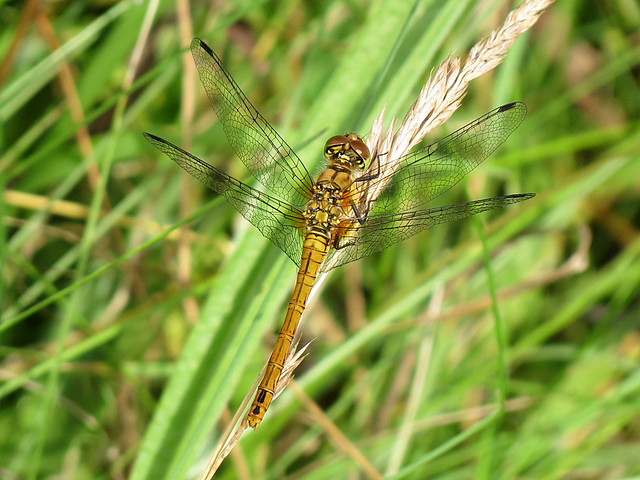
Yellowish throughout with black markings on sides of thorax and abdomen; legs all black.
Marshes, ponds, lakes, canals and ditches, with plenty of tall emergent vegetation. Will tolerate brackish conditions, using woodland near to water bodies for shelter.
Males are less aggressively territorial than Common Darter Sympetrum striolatum. They have a ‘skippy’ flight, being less direct than the latter species. Copulation lasts only a few minutes whilst perched on vegetation or the ground. The female will then oviposit either alone, or in tandem, amongst shaded vegetation. Larvae live among submerged plants and emerge after one year.